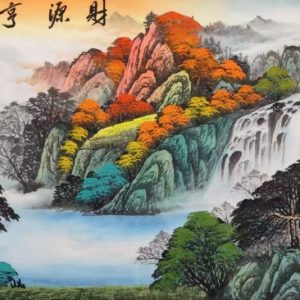What defines traditional Chinese art and how has it influenced Chinese culture throughout history

Traditional Chinese art is a broad and deeply historical category that includes painting, calligraphy, ceramics, sculpture, and decorative arts. Rooted in over 5,000 years of civilization, it reflects the philosophical, spiritual, and cultural values of China. Unlike many Western art traditions that emphasize realism and perspective, Chinese art focuses more on harmony, symbolism, and expression of the inner world.
1. Key Characteristics
Traditional Chinese art is heavily influenced by Confucianism, Taoism, and Buddhism. These belief systems shaped the themes, techniques, and purpose of artistic creation. Harmony with nature, respect for elders, inner peace, and spiritual awakening are recurring ideas in Chinese art. Artists often aimed to convey not just the outward appearance of a subject but its essence or spirit.
Brush and ink are the primary tools in many traditional Chinese art forms, especially in calligraphy and painting. The style emphasizes fluid lines, balance, rhythm, and minimalism. Each brushstroke is significant, often symbolizing a deeper energy or intention.
2. Chinese Painting
Chinese painting, or guóhuà, uses ink and watercolor on rice paper or silk. It is divided mainly into two styles:
- Gongbi: A meticulous, detailed style with fine lines and rich colors, often used for court paintings or depictions of flowers and birds.
- Xieyi (freehand): A more expressive, spontaneous style that focuses on capturing the spirit of the subject rather than its exact appearance.
Landscape painting, known as shanshui (“mountain and water”), is a major genre in traditional Chinese painting. These scenes are not just representations of nature but philosophical reflections on the universe and humanity’s place in it.
3. Calligraphy
Regarded as one of the highest forms of traditional Chinese art, calligraphy combines visual beauty with written meaning. The practice is meditative and deeply connected to the artist’s personality. Famous calligraphers like Wang Xizhi elevated writing to an art form, where brushstrokes carry emotional and cultural weight.
4. Ceramics and Porcelain
China’s ceramic tradition is world-renowned, particularly for its porcelain. Techniques developed during the Tang, Song, and Ming dynasties resulted in masterpieces like blue-and-white porcelain, celadon ware, and glazed pottery. These items were not only functional but also highly artistic, often decorated with dragons, flowers, or symbolic motifs.
5. Sculpture and Decorative Arts
Buddhist sculpture flourished during the Northern Wei and Tang dynasties, creating serene stone Buddhas and intricate carvings. Decorative arts included jade carving, silk weaving, lacquerware, and cloisonné—each showcasing refined craftsmanship and cultural symbolism.
6. Cultural Influence
Traditional Chinese art played a vital role in education, spiritual life, and politics. Scholars were trained in painting and calligraphy as part of their education. Artworks often carried messages of morality, nature’s beauty, and national pride.
Over centuries, traditional Chinese art has influenced East Asian countries like Japan and Korea and inspired Western artists through cultural exchanges like the Silk Road.
7. Influence on Modern Art
Many modern Chinese artists draw upon traditional themes, materials, and philosophies. For instance, they may use ink and brush on rice paper but explore abstract or global subjects. This fusion of old and new allows Chinese art to maintain its cultural identity while also engaging with modern global art trends.
Artists like Xu Bing, who integrates calligraphy into modern conceptual art, and Cai Guo-Qiang, who uses gunpowder in reference to ancient Chinese invention, are examples of how traditional Chinese artistic principles continue to inspire today’s creative expressions.
8. Preservation and Global Recognition
Today, traditional Chinese art is preserved through museums, galleries, cultural heritage programs, and academic institutions. In China, students often study calligraphy and painting as part of their education. Internationally, exhibitions of Chinese art—from ancient scrolls to Ming vases—are held in major museums like the British Museum, the Metropolitan Museum of Art, and the Palace Museum in Beijing (Forbidden City).
Moreover, UNESCO has recognized various traditional Chinese art forms, such as ink wash painting and paper cutting, as part of the Intangible Cultural Heritage of Humanity. This acknowledgment helps ensure these art forms are passed on to future generations.
9. Symbolism and Cultural Identity
Symbolism is a vital part of traditional Chinese art. Common symbols include:
- Dragons – representing power and strength.
- Lotus flowers – purity and spiritual awakening.
- Mountains and rivers – harmony between man and nature.
These motifs are still widely used in everything from home décor to fashion, helping maintain a strong link to Chinese cultural identity.
10. Art as a Reflection of Chinese Philosophy
One of the most remarkable aspects of traditional Chinese art is how deeply it reflects Chinese philosophical thinking. Taoism teaches harmony with nature, and this is seen in landscape paintings where humans are often small figures within grand natural scenes. Confucianism emphasizes order and discipline, evident in the precise techniques of calligraphy and formal portraiture. Buddhism introduces themes of inner peace, transformation, and enlightenment—visible in sculptures and temple murals.
Conclusion
Traditional Chinese art is more than visual expression—it is a reflection of China’s philosophical roots, cultural values, and historical development. Through elegant brushstrokes, symbolic imagery, and masterful craftsmanship, it continues to be a vital part of Chinese identity and global artistic heritage.


